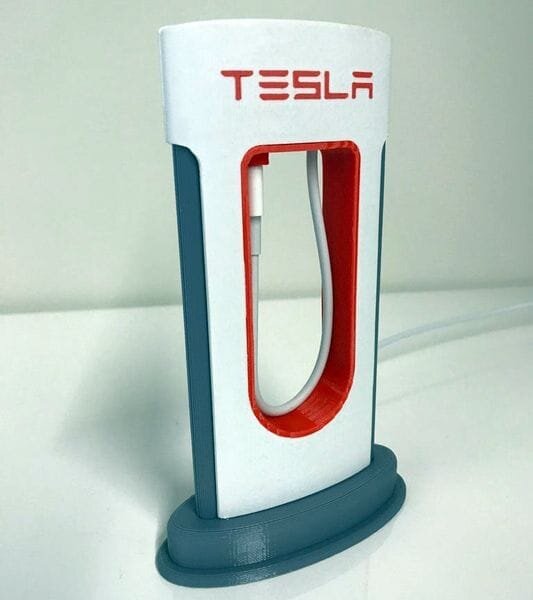![The Telsa Phone Charger [Source: Thingiverse]](https://fabbaloo.com/wp-content/uploads/2020/05/image-asset_img_5eb08c7c36687.jpg)
This week’s selection is the 3D printed Telsa Phone Charger by engineer Stephen Holmstead.
This is not a life-sized Supercharger, but in fact is a desktop version, and it can actually charge your iPhone! To use, simply pull out the charging cord and plug in your device in exactly the same way you might charge your Tesla, if you happened to own one.
You’ll note that this is a multicolor 3D print to ensure a realistic representation of an actual Tesla Supercharger. However, Holmstead has designed the 3D model to allow those without access to multicolor 3D printers to very easily 3D print and assemble the entire project.
Telsa Phone Charger Assembly
The idea is to 3D print the parts in three colors: grey, white and red. Then, the parts are assembled using a snap-fit approach. Of note are the “Tesla” letters in red, which would be tricky to implement. Holmstead has designed the white housing to include holes for the letters. These are printed separately in red material, and then pushed into the holes.
Holmstead has carefully designed the letters and holes with appropriate clearances to ensure the letters will actually fit. However, some who have attempted this project say they’ve had to use “aggressive” means to persuade the letters to insert fully.
There are two variations of this 3D model. The base version is designed to support the standard lightning cable used on older iPhones. A second set of parts can be used to set up the Tesla Phone Charger for use with newer iPhones that use the USB-C cable standard connector.
3D Printed Supercharger Design
Holmstead designed this model from scratch using the popular Autodesk Fusion 360 CAD tool, and he’s even provided the Fusion 360 file for download if you wish to modify it for use with other cable systems.
Apparently Holmstead saw other versions of this design, but was dissatisfied with the engineering of the parts. In his version, Holmstead ensured not only easy assembly, but also that the parts could be 3D printed entirely without support structures. This should be an easy 3D print project.
But you’ll need red, white and grey filament.
Via Thingiverse

